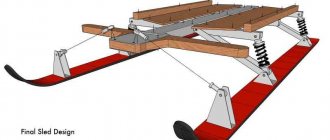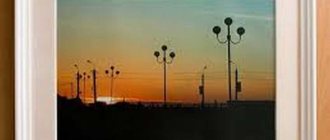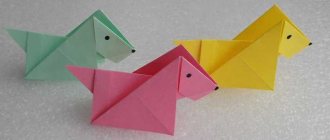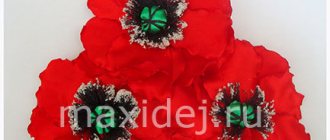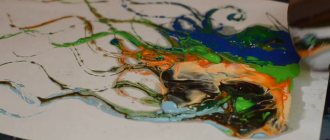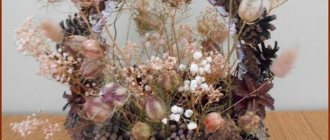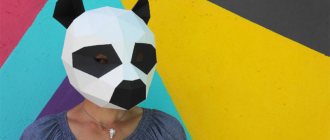Decorating your home yourself is a matter of honor for craftsmen and craftswomen who prefer an original and unique interior. Modern trends in interior decoration dictate the use of relatively modest and laconic objects.
Do-it-yourself modular paintings are just such minimalist types of decorations. Their simple geometric shape, the absence of frames, glass and other unnecessary details, allows you to create them yourself.
What are modular paintings
A modular painting is several canvases that are combined into one composition.
There are many options for the arrangement of elements:
- symmetrical arrangement in the horizontal plane;
- displacement and asymmetry horizontally and vertically;
- mixed vertical-horizontal;
The most popular are variations with symmetrical and asymmetrical offsets - they literally change the space of the room. It’s amazing how using this design technique you can achieve a visual increase in space. This is very important for arranging the interior of a small room.
Depending on how many parts the overall picture consists of, they are distinguished:
- diptych – 2 canvases;
- triptych – 3 canvases;
- polyptych - more than three canvases.
There are no strict rules for interior design using modular paintings. In addition, with the current capabilities of printing, you do not need to be an artist to make such a composition with your own hands. Isn't this a challenge for a truly creative person?
Design features
The main aspect that must be observed when making a frame with your own hands is the design and intended purpose of the room where the product will be placed. When choosing a color scheme, it is important not to overdo it. Since shades that are too bright and saturated will be uncomfortable for visual perception, the finished frame will also not be able to fit into the interior.
The canvas in such a frame will lose all its advantages, fade and lose significance.
Additional Information! Try to focus your design on the content of the photograph or painting, as well as its parameters. The more colorful the picture, the smaller and more inconspicuous the frame should ultimately be.
If this has already happened, don’t worry, you can make adjustments to the shape, color and design at any time. This possibility is the main advantage of making a frame with your own hands. Using various available means and design options, it will be possible to transform the picture that was planned to decorate the room.
For small images and photographs, there are many interesting ideas for using scrap materials.
Another method is to place the canvas at a non-standard angle, changing the lighting, or near certain furniture to create a single picture. By making and correcting mistakes or trying different placements, you will achieve excellent results.
Required materials and tools
The main part can be made from a variety of materials. These could be images on paper that were printed in fragments on a regular home printer, paper with pictures from a printing house, wallpaper with a design you liked, fabric with a print, and so on. The material from which the frame will be made depends on the selected front part. A wooden frame is ideal for fabric, photo wallpaper is best glued to foam sheets, and paper attaches well to chipboards.
So, to make from wallpaper or other material you will need the following:
- Printed images.
- Thin wooden slats, polystyrene foam, chipboard and so on.
- PVA glue.
- Tape measure or meter.
- Construction stapler.
- Pencil, marker, chalk, soap.
- Scissors.
Tips for craftsmen before creating a frame
The design chosen must be appropriate to the surrounding environment. It is not necessary to make a gilded frame in a simple granny’s apartment, and a simple frame made of plastic molding will not fit into the decoration of a hall with columns.
Select the dimensions of the work and frame wisely. A wide border and a small canvas will not look stylish at all.
Explore the variety of frame materials available. You can glue not only cardboard and “plinth”, wood, polyurethane, natural materials, wire, twine and much more are successfully used by designers around the world.
Before admiring the finished masterpiece, you will need patience, skill and great desire.
Types of modular paintings
Modular painting made of fabric
Those who don’t know how to make a modular painting themselves should understand the types, or rather, the materials from which the canvas can be assembled. Types of materials for paintings:
- Textile.
- Wallpaper, possibly photo wallpaper.
- Photo.
- Colored paper.
The canvases look good if you draw them with your own hands, using canvas and gouache, but this requires a good master, which a class can demonstrate. Without artistic skills, the product cannot be made. Making a modular painting is not difficult, so anyone can make a similar decoration for their home, even without creative inclinations.
Types of modular paintings
The main component when working with finished paintings is accuracy in work. The object can be placed diagonally, along certain lines, or abstractly. The module and its shape will create a certain effect. They are divided into:
- Square.
- Round.
- Arbitrary.
Of course, the easiest way to create a segment is the correct geometric shape, namely rectangular.
Video lessons
As can be seen from the manufacturing algorithm, modular paintings consist of only a few parts: you only need a base and fabric, paper or canvas for the final design. Next, everything needs to be connected correctly - and the picture is ready. For those who prefer things made on their own, such master classes will be especially useful. They are described more clearly in videos, after watching which it is easy to construct any composite picture.
Step-by-step master class for beginners
How to draw flowers
Making modular paintings with your own hands
Before starting work, we will need to prepare a small arsenal of materials and tools that can be found at home or at the nearest hardware store. The canvas itself with the image can be printed on your own printer or ordered from a printing house. Many people make a picture frame themselves from bars and fasteners, but we recommend purchasing a ready-made one for the first time.
We prepare everything you need
First of all, choose a canvas: print, write or use photo wallpaper. Next, you will need to choose what the image will be attached to.
- Make a frame from timber.
- Buy a ready-made stretcher at an art store.
- Use a photo frame.
- Attach the painting to drywall, fiberboard or plywood.
For all options you will need to stock up on the following materials:
- glue - if you use wallpaper or photos;
- stapler - useful for securing the canvas (if you use it);
- scissors - for cropping images.
Now let's move on to a detailed guide on how to make a modular painting with your own hands with step-by-step instructions.
Step-by-step instruction
When you have selected a drawing, prepared the material and frame, you can move on to the step-by-step instructions with a photo example.
- Take a fabric of a suitable size and place the frame on it. Stretch the fabric and leave a couple of centimeters around the edges, and cut off the excess.
- Make sure that the fabric lies neatly and that there are no folds in the design. If you did everything correctly, use a stapler to secure the fabric. If in your case there is paper or a photo, you can glue them.
- The module is ready, now you can hang it on the wall.
This way you can make a picture from modules or divide the photo into several parts, it all depends on your imagination. The main thing is to understand the essence of this DIY, and then it will be easier.
Now you know how to make modular wall paintings with your own hands. We gave an example with classical abstraction, and we suggest you try experimenting with images so that different modules create one picture.
Using scrap materials
Unlike the previous method, it is much easier to make modular paintings from wallpaper with your own hands. As a decorative material, you can use any wallpaper you like, a drawing printed in a printing house, family photographs, portraits of your favorite film artists, or decoupage cards.
For such paintings you will also need a stretcher with chipboard or plywood. You can buy it or make it yourself. The color image is drawn, cut out and attached to the flat base of the stretcher. For fixation, use special glue, double-sided tape or a construction stapler. The disadvantage of using liquid glue is that the paper softens and deforms, so you should experiment in advance on an unnecessary fragment and select a suitable material.
Before you make a modular picture with your own hands from photo wallpaper, you need to make sure that the finished elements are correctly matched on the wall and create a single plot. Therefore, wallpaper cutting should be carried out taking into account hem allowances. An alternative would be to cover the end of the subframe with another material. In this case, the area of the picture coincides with the surface area of the subframe.
Modular paintings from photo wallpapers
- Several slabs of foam plastic should be prepared.
- Then you need to apply markings on them that correspond to the sizes of future fragments of the composition and cut the material according to it. It is best to use a special thermal cutting machine, but this tool is quite expensive, so it is not advisable to buy it to make one painting. You can take a utility knife and carefully trim the foam.
- Then you need to cut the photo wallpaper, leaving 1-2 cm for overlap.
- At the end, the wallpaper is simply glued onto the prepared base and ironed thoroughly.
You can make a beautiful modular picture from photo wallpaper very simply and without extra financial costs. Creating your own masterpiece is quite simple. Even a novice master can cope with this task; it is only important to follow the above recommendations and act as carefully as possible.
Further improvement
If you look at a picture in a frame in an engineering way, you will notice an obvious discrepancy: the stretcher, which already carries the most valuable thing - the image - is also loaded by the frame. Which can also be a non-destructive damper when a painting falls. How to eliminate the first and achieve the second? From a technical point of view, it’s trivial. It is necessary to strengthen the stiffening rib of the frame under the plaster molding, then it will become self-supporting, and the stretcher with the painting will simply lie in the frame. How to strengthen? Yes, replace the slats with timber, which is technologically no more difficult, not much more expensive and, on the whole, inexpensive. For brevity, we will call the resulting main power unit of the frame a frame, since there is already a subframe. For images on a thin base (paper, fabric, film), we use the same principles of fiberboard. Now, if a painting falls, all you have to do is lift it, check the hanger and hook, adjust them if necessary, and hang the frame with the painting in place.
For "real oil"
The construction of a reinforced frame for paintings on a stretcher is shown in section in the figure:
Construction of a reinforced frame for a painting on a stretcher
At pos. A – without internal frame; on pos. B with "milk". At pos. B – detailed section of the frame; board with timber and form a frame. The glass thickness is 4 mm, the same as a standard fiberboard. If glazing is not provided, the spacer between the board and the baguette is excluded. Foam inserts act as soft springs holding the subframe in place; wooden wedges sometimes tear the canvas, but foam plastic certainly does not. The thickness of the inserts is 3-4 mm greater than the width of the gap between the subframe and plywood gussets; material – coarse-grained packaging foam. The manufacture of a reinforced frame is carried out at the same time as it frames the picture:
- Blanks are cut out to assemble a frame from half-timbered timber using screws and glue. The inside dimensions of the frame are 2-3 mm larger than the width and height of the stretcher with the canvas. It is convenient to make cuts for joints with a metal hacksaw; it cuts wood well both across and along the grain, and the cut is smooth. Installation (pioneer) holes are drilled under the self-tapping screws with a diameter along the body of the hardware without threads and a depth of 2/3 - 3/4 of its length. For self-tapping screws 3.5x20 - with a diameter of 2.5-2.7 and a depth of 12-15 mm;
- the stretcher with canvas along the edge is wrapped with PE film;
- the timber frame is assembled roughly: without gluing, and the screws are not screwed in completely;
- the rough frame is placed on the subframe from behind (from the back), so its distortion is automatically corrected;
- Apply 2-3 drops of liquid nails or PVA into the joints and tighten the screws. A minimum of glue is also allowed on the back side so that it does not leak onto the front side of the canvas;
- when the glue sets, carefully remove the frame from the back;
- Once the glue has completely dried, install the boards under the baguette, the glass gasket and the internal frame (both if necessary);
- in plywood gussets, holes are drilled along the full diameter of the screws, and in a frame made of timber, respectively. im installation;
- put the glass in place. You can glue it along the edge with a few drops of silicone;
- glue the baguette, rub its diagonal seams and paint (see below);
- put the stretcher with the picture into the socket of the frame;
- if the painting is especially valuable in a frame with glazing, put a bag or several with silica gel in the back niche, and the entire rear is sealed with cardboard, soaked in PVA diluted 3-5 times with water, and completely dry - so that the glass does not fog up from the inside;
- lay foam inserts;
- put the plywood gussets in place. Without gluing, so that you can remove and remove the picture from the frame if necessary;
- They attach the pendant, hang the picture in place, admire it, rub their hands and say to themselves: “Oh, what a great fellow I am!”
Baguette substitutes
A factory-made frame baguette is still not cheap. As its substitutes for frames, without any special pretensions, they most often offer semi-urethane ceiling friezes (in trade - ceiling plinths or ceiling moldings) or floor plinths made of wood or MDF.
How to choose a profile for a ceiling plinth on a baguette for a picture
Polyurethane is easily processed at home, but not every ceiling frieze profile is suitable for a picture molding. From those shown in Fig. friezes at pos. are more or less suitable for this. 1 and 2, if you glue them to the board as shown there. Ceiling plinth for pos. 3, no matter how you place it, will give a large geometricized outer edge, and the painting will appear “in the box”, see above. Thin-walled friezes for LED lighting (pos. 4) along the profile on a baguette frame are most often suitable, but are fragile.
Gluing, puttying and painting of semi-retane substitutes
Semi-urethane baguette blanks for paintings are cut at the edges at 45 degrees. When manufacturing a reinforced frame using the technology described above, perfectly precise fitting to the size of the subframe is not required; A cutting accuracy of 1 mm is sufficient. Polyurethane is quickly and firmly glued to wood with polystyrene glue. It is easy to prepare it yourself on the balcony or in another well-ventilated area. To do this, add polystyrene foam granules little by little into 20-50 ml of technical (not fuel!) gasoline or kerosene until you get a composition with the consistency of sour cream. You will need a lot of polystyrene foam, and you cannot throw it all into the solvent at once: the granules hiss and foam.
Note: it is on this “self-adhesive” that homemade SIP panels are assembled. Frozen foam “self-adhesive”, unlike branded polyurethane, becomes brittle in the cold. There is no need to explain how this affects the strength, durability and safety of SIP buildings.
Any white putty is rubbed into the joining seams of the polyurethane baguette parts. After 5-15 minutes, residues (external smears, drips) are removed with a slightly damp cloth. After another day, the baguette can be painted with oil, acrylic or water-dispersed paint; alkyd enamel can corrode the material - depending on its quality, which is visually impossible to determine in advance.
A high-quality polyurethane molding with imitation wood carvings can also be painted to resemble old bronze:
- The first layer of blacksmith's patina (such paint is sold in art stores) is applied with a soft painter's brush. It doesn’t have to be an expensive kolinka, the simplest of hairs from a bull’s ear will do.
- When the patina begins to set, use a slightly damp sponge to go over the protrusions until the base shows through, without “rubbing” into the depressions.
- Using a spongy or fleecy roller, again without pressing it into the depressions, apply bronze (copper, gold, silver) metallic paint.
- The metallic that has begun to set is shaded like the patina, but not on the bumps, but in the recesses.
Note: painting with “antique metal” requires, in addition to accuracy, also solid skill, so it is better to first practice on a piece of the same baguette. Also about making picture frames from ceiling plinth, see the video below:
Video: picture frame made from ceiling plinth
An important advantage of a polyurethane baguette is the imitation of wood carving, however, if you look closely, the fake is noticeable, and the material is fragile.
Substitutes for baguettes made from wood materials: natural wood or MDF look much more reliable and solid. Affordable ones are produced without complex terrain, but this is more than compensated for by durability and naturalness. A noble material is a noble material, especially since the technique of texturing MDF to imitate valuable wood has reached a high degree of perfection, and ceremonial portraits in pompous frames are now not in fashion even among oligarchs.. Floor plinths and boards for platbands, suitable for picture framing
From the floor plinths (on the left in the figure) you can select paintings suitable for framing on a bright, colorful wall - a large outer overhang slanted inwards will highlight it. A picture in a frame made of boards for platbands (in the center) will look great in the interior of modern laconic styles, and from furniture beads (shaped edges and edgings, on the right) in styles with a decorative bias such as Art Deco shabby chic or haberdashery, as well as traditional ( country, rustic, colonial, etc.).
Putty and grouting
A picture frame made from wood substitutes for baguette looks best if its front connecting seams are invisible. The procedure for completely grouting the seams of wooden parts is painstaking, but you can master it the first time:
- The putty is acrylic, as close in tone as possible to the front side of the frame, but not darker. Available in pure white or dark brown under the trade names “pine” (yellowish), “oak” (light brown), “walnut” (brown), etc.
- You also need to prepare some acrylic paint exactly to match the wood. To do this, gradually add brown or dark brown paint into the white paint. Each additive is thoroughly mixed, then a drop is taken, dried with a household hairdryer (dries quickly) on glass, a piece of white PVC, etc., and compared with the tone of the wood surface.
- The seams are rubbed with putty as described above.
- When the putty dries from the surface (this is 10-20 minutes), apply a few drops of paint to the seam at intervals of 1-2 cm along the length and immediately rub it with a slightly damp, clean white cloth both along and across the seam.
- Touch-up and rubbing is repeated until the seam matches the tone of the main surface. Usually 2-3 passes are enough for this.
Fiberboard frame for drawings and embroideries
Few people paint or buy canvas paintings. Images on thin flexible media are much more accessible: watercolors, appliqués, drawings, etchings, engravings, offset printed images, photographs, embroideries, paintings on silk. The last four, if antique and old lithographs, can be of considerable commercial value. For such pictures it is much easier to make a frame from fiberboard.
The construction of a durable fiberboard frame for images on a thin base, with the possibility of glazing and creating an internal frame, is shown in the figure:
Making a frame made of fiberboard for pictures on a thin flexible base
The entire structure is designed to be edged with a starting profile for plasterboard (pos. D) of a suitable standard size. "Pocket" for children. And it’s only needed for pictures on paper or cardboard. The assembly of such a frame is also carried out at the same time as the picture frame:
- cut out children A, B and C;
- for children And they immediately make a suspension;
- cut, trim the ends at 45 degrees and cut to size according to the details. And the sidewalls and lengths of the outer frame. Rough trimming is done with side cutters, and precise fitting is done with a mounting knife and rubbing on a board with emery or a file;
- for children And they stick on PVA children. B. The glue is applied closer to the edges so that drops of it do not squeeze out;
- if the picture is on fabric or a charcoal drawing on paper, it is immediately put in place and PVA is glued to the corners. In this case, further work will require increased accuracy;
- for children B stick children. B with the same precautions as in paragraph 3;
- The bottom and side strips of the outer frame are glued with mounting glue;
- glass is inserted;
- if the picture is more or less permanent on paper or cardboard, insert it into place through the pocket on the child. A;
- put the top bar of the outer frame in place;
- fill the seams with PVC mastic (see below) - the picture in the frame is ready.
Mastic for PVC
To prepare mastic for sealing joints on PVC, you will need 2 glass medicine bottles with a double gas-tight stopper. One, with dichloroethane, is purchased. The second, for ready-made mastic, for example. from hydrogen peroxide or ammonia, filled with small scraps and crumbs of the same plasterboard profile, and filled half with dichloroethane. You need to prepare mastic outdoors or in a well-ventilated area - dichloroethane is a volatile, very toxic and fire hazardous substance.
After a day or two, when the PVC has dissolved, check the consistency of the composition; it should be creamy. If it is too thick or the filler has not completely dissolved, add a little solvent. The finished mastic is taken in drops with a toothpick or other pointed stick, applied to the seam and “stretched” along it with the tip of the same stick. There is no need to smear, smooth or rub very much, it will spread as it should. Complete drying within 24 hours.
Note: a stronger and more durable frame of the same design can be made from thin plywood, but you will have to work with a jigsaw. Manual - electric will not work beautifully.
Read more about decorative paintings
Decorative paintings usually consist of 2-3 or more canvases, and if you combine them, you get a full-fledged image. They are usually arranged like this:
- horizontal or symmetrical;
- the image can be shifted vertically or horizontally;
- You can also mix them and hang them horizontally or vertically.
We have given small examples of a typical arrangement, but the most important thing is that there is no special rule for how to arrange them correctly - it all depends on your imagination.
Interesting information: modular paintings of two or more canvases visually increase the area of the apartment. Owners of smart apartments can take note.
These images even received certain names, which depend on the number of paintings. For example:
- a couple of modules - a diptych;
- painting of 3 parts - triptych;
- images of 3 parts are called polyptych.
In this direction of decor, you can experiment without boundaries and create canvases in any design.
Types of paintings
Before you make decorative paintings with your own hands, you need to understand what types there are and what material can be used. Let's begin! What can the canvas be made from:
- regular fabric;
- wallpaper: vinyl, non-woven or photo wallpaper;
- printed photographs or drawings (think about the size of the layout in advance and print the images at a printing house);
- colored paper;
- self-painted paintings.
It became popular to paint canvases yourself, decorate them with different decor and give the picture volume. Handmade lovers are experimenting with modular paintings and placing objects along different trajectories: square, round or arbitrary.
Tip: if you are good at Photoshop, you can process each image in advance, including the canvas size. Also in the program you can estimate how the finished modules will look together.
Frame improvements
With the beginning of industrialization and mechanization of production, first lithography techniques appeared, then photography and offset printing, which made it possible to replicate pictures. At the end of the 19th century. Color photography and color offset already existed. Great works of fine art in copies have become available to thousands of people, although not yet to millions. In this regard, inexpensive material for picture frames and a simpler technology for their manufacture were also required.
Profiled slatted frames in the sweatshop conditions of the brutal dawn of capitalism turned out to be unprofitable, because their production required the involvement of expensive skilled labor, which still retained the corporate spirit of medieval workshops. Therefore approx. in the middle of the last century, a baguette was invented in France - a cheap decorative overlay that imitates carved wood and is suitable for mass production by unskilled workers. Perhaps this is where the name comes from: une baguette is the French people's bread. A loaf of baguette with a piece of cheese or dried fish and a glass of wine constituted the usual lunch of a French worker at that time, and France itself was a world leader in the arts. Frame frames for pictures turned out to be so popular that the name became a household word: now a frame for a picture and a baguette for a picture are semantically (in meaning) the same thing.
Types of baguette and the device of a baguette frame for a picture.
At first, the baguette was made cast from gypsum plaster mortar with finely chopped fiber filler; one wooden casting mold, subject to timely impregnation with linseed oil, could withstand more than 10,000 castings. The gypsum molding adheres perfectly to wood with ordinary wood glue, so the frame itself, as a load-bearing (load-bearing) structure, was made from simple timber (on the left in the figure). The slats - stiffening ribs - are connected halfway across the tree, which is not difficult and does not require special equipment, and the boards for the molding are simply butted. The finished frame was usually painted bronze without tinting or “antique”, see below.
Gypsum frames are still common today. It is this design that we will be most concerned with - despite its simplicity (perhaps thanks to it), it contains great technical potential for improvement and modification.
But noble carved wood as a material for frames has now almost completely replaced baguette, pressed MDF, textured like valuable wood, in the center in Fig. The material is not cheap, but still affordable to the wealthy craftsman. Since the viscosity of MDF is much higher than that of natural wood (MDF does not splinter), frame parts made from MDF baguette are connected with corner (oblique) plywood dowels using glue, on the right in Fig. We will talk about some of the subtleties of this process (grouting joints) later, but before that, keep in mind: cutting under the key is done correctly only if you have a desktop vertical wood router with a saw blade installed in the spindle. Manually or with the help of homemade devices, the connection of the lengths with the cross members is almost always obtained with a ledge, which is an unacceptable defect in this class of products.
How to choose a modular painting?
Each room has its own characteristics, its own tasks and goals. The correct choice of decorative elements will highlight all the advantages of the room and minimize the disadvantages.
Living room
An ideal room for experimenting and using bright and rich colors. Designers advise choosing the size of the segments in accordance with the area of the room. For example, small elements can get “lost” on a large empty wall. At the same time, large segments will look ridiculous in a small apartment. Modular paintings above the sofa look great .
Bedroom
The painting for this room should be selected carefully, weighing all the pros and cons. Give preference to calm landscapes or abstract images . They will allow you to escape from worries, relieve stress and fall asleep peacefully. It is best to select an image so that the primary colors intersect with the palette used to decorate the bedroom. This way you can achieve complete harmony and incorporate a modular painting into the interior.
Children's
Don't overload your child's room with bright colors. If there are enough of them in the decoration of the room, then it is better to choose a picture in one color scheme . The baby will be interested in figures of familiar animals , but it is better to avoid abstract patterns.
If a teenager lives in the room, then invite him to make his own choice. Your favorite film actor, musician or athlete may appear on the canvas. Another interesting option is to create a composition from your own photographs .
Hallway
For the hallway, designers advise choosing the simplest images possible . This is due to the fact that people rarely stay in this room. The owners and their guests simply will not have the opportunity to carefully examine a painting with an interesting abstract pattern. Remember that the hallway sets the tone for the entire interior of the apartment, so the design should emphasize the chosen style.
Kitchen
Juicy, bright and stylish - this is the ideal combination for the kitchen. You don’t have to be afraid to experiment, but the image should still be combined with the interior of the room. Modular paintings for the kitchen are best placed on a free wall . If there is not a lot of space, then it is better to abandon the decor and give preference to more functional shelves.
How to decide on the design and size of a picture frame
What determines product design? The interior surrounding it. It’s not enough to just want to see a blue ornate frame on a picture in a room with a classic interior - so we focus strictly on the style of the room.
Classic frames make your home cozier
Frame width plays a big role in perception
We don’t forget that no matter how beautiful the frame is, the main thing will be the picture, so when choosing a design we remember the goal: to decorate and complement
The size of the canvas and the image itself will tell you which sizes are preferable. Agree, if the canvas is small and the frame takes up half the wall, this indicates problems with the person’s taste.
Paintings on canvas
Do-it-yourself modular paintings, created as an alternative to original canvases, imply the use of high-quality materials and specific technology. The basis for applying the decorative layer is canvas.
Artist stores offer a wide selection of different blanks, including a durable wooden stretcher with canvas stretched over it. The assortment of such stores often depends on the demand for such products, so finding materials in provincial cities can be problematic. The solution is to search and buy everything you need in online stores.
The selected pattern is applied to the finished base using any available technique (oil, pastel). Such modular paintings, made with your own hands, are a real work of art.
In cases where the image cannot be drawn, it can be applied to the canvas using a special printer. A ready-made base with a subframe will not be suitable for this task. You will need to purchase the canvas and mounting for it separately. Canvas printing is a fairly common service offered by many printing houses.
An important point: before you make a modular picture with your own hands, you should carefully plan the location and boundaries of each of its elements. The canvas with the printed design must be stretched on a stretcher, which means that each element of the composition must be printed separately with a sufficient supply of clean canvas around the edges.
The old fashioned way
Artists painted pictures when there was no trace of mechanization of production and mechanized tools. Since those ancient times, the traditional design of frames for prestigious paintings of high artistic and material value has developed.
The carved wooden frame with the painting is shown in section and from the back in pos. 1 pic:
Traditional expensive picture frame design
Mechanically (technically, structurally) its essence is that the main force load (including from the frame) is borne by the painting’s subframe (a frame made of wooden beams on which the canvas is stretched); The stretchers of large canvases are reinforced with crossbars, steel corner plates or plywood gussets. In the event of a painting falling, the frame acts as a collapsing damper - it falls into pieces, but the canvas (perhaps of immeasurable value) remains intact or, at least, suitable for restoration.
Such frames are made individually for paintings. The stretcher with the canvas is inserted into the frame and secured in it, using traditional technology, with small wooden wedges. The rope suspension is attached to the subframe.
Just because of the carved wooden frame alone, its cost is truly royal. The frame parts are connected by joinery joints, bevel tongue and groove (positions 2 and 3 in the figure on glue, and then the frame is held together in a wedge wedge, position 4. The whole technology requires a well-equipped carpentry workshop and worker(s) with solid carpenter skills -cabinet maker. This did not bother the medieval customers at all, on the contrary - since he can afford to order or buy a painting, then the frame should match it. A unique frame, a work of art in itself, frames the painting of the great master, and this lord (sir , sir, Herr) their owner - isn’t this evidence of nobility and dignity?
The original oil painting is still of great value, but line monochrome images and drawings (engravings, etchings, watercolors) in the old days were quite widespread in the homes of the middle classes and the poor. Works of applied art - embroidery, applique, modular (from real objects) compositions even more; The human attraction to beauty is eternal and ineradicable. Simpler pictures were inserted into cheaper frames made from profiled wooden slats; While there were no wood milling machines, the slats were planed into profiles manually using special planes - zenzubels - with shaped pieces of iron. Slatted picture frames are still in use today, but to make them you still need an equipped carpentry workshop, see for example. video:
Video: simple and durable picture frames (in the workshop)
How to make a modular picture from photo wallpaper
Modular paintings can be made on different bases, depending on the preferences of the person and the requirements of the interior. So with wooden dies the images will be more accurate. If a more voluminous panel is required, foam should be used.
What you will need to create a modular painting:
- photo wallpaper;
- Styrofoam;
- cardboard;
- colored or white paper;
Modular picture from photo wallpaper
- PVA glue;
- threads;
- scissors;
- stationery knife.
- Select photo wallpaper, outline and cut out a fragment of the desired size in a square or rectangular shape.
- Cut the cut fragment vertically into several more pieces. It is best to divide the picture into 3-5 fragments.
- Take a plate of foam plastic, measure out rectangles on it that correspond to the fragments of the picture, cut them out with a stationery knife and sand the edges.
- Glue the parts of the picture onto the foam plates using PVA glue.
- Cover the sides with paper of the appropriate color.
- At the back, using thread and cardboard, make loops for attaching the pictures to the wall.
Advice. Instead of polystyrene foam, you can use plywood, a sheet of chipboard, or thick cardboard. But if you haven’t found the photo wallpaper you need, you can select a suitable image on the Internet and print it on a special printer.
Sequence of work
The cut out fragments are placed on the surface of the subframe and fixed with temporary fasteners at several points (pins or thin nails). Then the workpiece should be turned over, allowances should be placed on the wrong side and sequentially attached to the stretcher. You should start with the long sides, then move to the short ones. Lastly, fold and secure the corners.
It is necessary to avoid excessive tension of the canvas, as this will lead to deformation of the pattern. If desired, the ends can be treated with tape, and decorative elements can be attached to the front surface of the painting.
Lastly, the hinges are nailed from the inside out and then the pictures are hung on the wall.
Modular paintings in the interior
An excellent addition to the design of the room will be original do-it-yourself modular paintings made from wallpaper. The master class for making them, discussed above, will allow you to create unique masterpieces; you just need to take into account that for each room you should select images that correspond to the overall design so that the atmosphere is harmonious.
Paintings for the living room
Paintings with city landscapes will look natural in the living room. Within the framework of modern stylistic trends, it is better to choose monochrome or not too bright color photo wallpapers with skyscrapers, bridges and roads of large cities.
To complement a living room decorated in modern or high-tech style, unusual, abstract or clear geometric images are suitable.
Compositions with various floral prints, as well as photo wallpapers with flowers shot in macro mode or just close-up are quite universal.
Paintings for the bedroom
The main condition for a comfortable stay in the bedroom is to create a suitable relaxing environment. Modular decor for this room should be selected based on the overall design of the room, but be sure to avoid oversaturation with bright shades. Natural landscapes that depict mountains, trees, forests, fields, sea, sunsets are considered universal.
Floral images are also very popular. They can be contrasting or match the overall color scheme of the bedroom.
Paintings for the kitchen
To make it easier to care for a painting in the kitchen and preserve its original appearance for a long time, it is best to place such decor above the dining table, away from the stove and sink. The ideal choice is plot motifs related to food in one way or another.
Most often, the kitchen is decorated with images of fruits, pastries, tea and other drinks. With the correct selection of shades, such paintings fit optimally into the surrounding environment.
Unusual bright scenes made in different styles also look impressive.
An excellent way to diversify the interior and add new interesting accents to it is to use modular paintings created with your own hands from wallpaper.
A master class describing a simple technology for making such decor, discussed in this article, will allow you to make original hand-made creations that can give a particular room a certain zest.
About frame design
A picture frame should highlight the image in its surroundings and draw attention to it. In some cases (see below), the frame aesthetically coordinates the image with the surroundings, but in no case is it an integral part of the composition semantically, i.e. The meaning of the image should remain the same with or without a frame. Therefore, the “hyperdesign” of picture frames (see figure) is only permissible in one single case: if the semantics of the picture are so weak that without a frame it escapes the viewer’s attention altogether. Simply put, if the picture is a product of bad taste and without a frame, it is not worth more than a fleeting glance. This does not concern the purely physiological aspects of its perception, but then we should no longer be talking about the art and artistic value of the image - “interestingness” can also be different. Such reasoning may seem sophisticatedly aesthetic, but quite specific ones directly follow from them, incl. technical requirements for the picture frame.
Picture frames that distract the viewer from the meaning of the image
Baguette profile
Even ancient cabinetmakers figured out the easiest way to concentrate the viewer’s attention on the picture. To do this, a sufficiently wide baguette for the picture should rise smoothly from the image carrier outward. This is also a physiological way of attracting attention, but without “switching on” base instincts. Since primitive times, it has been common for man to peer into all sorts of holes: after all, there may be edible prey, water, or danger lurking there. Children do not immediately lose their original spontaneity of perception of the world, which is why they are tempted to look into wells, caves, utility hatches, drainage pipes, etc.
However, a hole that is too deep suggests something more dangerous than useful - what you need in it is difficult to access, and the danger may turn out to be too big and biting or poisonous. Therefore, the same old-time masters, through trial and error, determined the optimal camber of the sides of the baguette: the tangent to the envelope of its profile at its lowest internal point should form an angle of 15-40 degrees with the image plane. the wider the baguette is compared to the picture, the larger this angle can be, but there is no more or less exact formula, this is a matter of taste and skill of the master. Such a frame forms around the image something like the eyepiece of a large telescope, through which the viewer examines another world - in the picture.
Note: a correctly profiled baguette also performs, so to speak, an aesthetic and protective function - it softens or completely eliminates glare and natural shadows in the picture under oblique lighting.
As for the outer edge, there are 2 options. If the picture is placed on an aesthetically favorable background (not overly bright and variegated), then it is better to make the outer edge of the baguette also beveled at an angle, generally approx. twice the size of the internal one, pos. 1 in Fig.:
Correct and incorrect profiling of a baguette for a picture frame
If the picture needs to be highlighted more strongly against the background, then one of the options is a baguette hanging slightly from the outside, pos. 2, so it will obscure the brightly lit background directly next to the picture, and the background on the shadow side will not “clog” the image so much. In industrially produced baguettes, a manually labor-intensive, but in every sense optimal solution is used - a concave profile of the outer edge of the baguette (see profiles of MDF baguettes in the figure above).
In any case, it is unacceptable, firstly, any overhang of the inner edge of the frame over the image (positions 3 and 4 in the figure) - a shadow edging on the picture will sharply reduce its visual appeal. Secondly, the straight high outer edge of the frame (item 5) - the picture “in a box” will receive some added utilitarianism, most often inappropriate. The only exception in this case is deep modular compositions. They don’t look good at all in wide “flattened” frames, and then you still need to make a “box”, but paint or trim the outside so that it blends better into the background.
Picture in frame with “milk”
The “milk” in the frame of the picture is more akin to the “milk” of a shooting target than to the milky shot in cinematography. In our case, “milk” is a semantically empty field between the outer edge of the image and the inner edge of the frame. Simply – the inner frame of the picture.
Most often, a frame with “milk” for a picture needs to be made if the backgrounds of the picture and the surrounding ones are close to each other in brightness and color tone, on the left in Fig. If the picture as a whole is light, then its internal frame can be dark to pure black or light to white; if it is dark, then only white.
Examples of paintings in frames with internal framing
In the center in Fig. - an infrequent, but interesting and difficult case to solve aesthetically. An additional fragment (a blue vase) that perfectly harmonizes with the main semantic elements had to be placed near the so-called Golden Ratio Zone - the area in the image that most attracts the eye. To “drag” the viewer’s attention to the daisies, the author found a non-standard solution - he painted a narrow slatted frame to match the vase. According to the physiology of visual perception, the viewer’s attention in this case is in the position of Buridan’s donkey, but the “carrot” under his nose – a bouquet in a vase – prevents him from dying of hunger between two identical armfuls of hay. However, without the “milk,” the frame and the vase would have formed something semantically common, which the artist did not intend and which would have spoiled the painting. The internal frame of a contrasting blue, but much duller and paler tone solves the problem - the blue elements do not tire the eyesight, but the vase, due to the fact that it is almost in the golden ratio, is not lost from view. In general, this is the same case as mentioned above - the frame emphasizes the meaning of the image without changing it.
The second case (on the right in the figure) is even more complex and subtle; This is already the highest aerobatics of image framing. What is obvious about it is that a ceremonial portrait without a magnificent frame is no longer a ceremonial portrait. If the picture depicted a white woman, there would be no need for “milk”: powder her face, put on jewelry, and a bright light main semantic spot is exactly where it is needed according to the rules of the central vertical composition. The “milk” tone in the overall image tells the viewer’s subconscious that the frame here is only a symbol of etiquette, and the essence is expressed in the lady on the canvas. But why exactly in the tone of the image? And why is it made quite monochromatic, and not in contrast to the color of the model’s skin? These are, unfortunately, too complex questions for detailed analysis here. Just look closely at the same picture next to it, on a white background. Even from a small-scale JPEG it is noticeable that the character’s facial expression is somewhat different here and there. And if on white we see just a posing model, then in a frame with “milk” to match the color of the skin on the face, a certain hidden essence is revealed. And no photoshopped photos - just copied to the clipboard and placed next to it on white. This is what the internal framing of a framed painting can mean.
Material for “milk”, and not only
Front (smooth) side of rough fiberboard
The inner frame of the picture is in the center in Fig. above (probably together with the subframe) seems to be made from rough fiberboard. Its smooth side is just the right tone and finely textured, like wood that is always pleasing to the eye, see fig. on right. White fiberboard for the backs of furniture is no worse than ordinary “milk” for paintings; Any fiberboard can be easily painted or covered with textured self-adhesive. According to its mechanical characteristics, fiberboard is suitable for the manufacture of almost all elements of the load-bearing part of a picture frame. Fiberboard does not generate dust, does not stain anything, does not emit toxic fumes, and can be cut with a mounting knife. It’s a little difficult, really - to cut through a 4-mm slab, you need 3-5 passes with a fresh, never-used blade. But no dust, no sawdust or shavings, no noise or rumble. In general, fiberboard is an excellent material for a picture frame, which is what we will now do directly.
Differences in the purpose of the subframe
According to their purpose, subframes are divided into several categories. These are stretchers for canvas, stretchers for batik, stretchers for diamond embroidery, tapestries, etc.
Canvas stretcher
The shape of a stretcher for a painting or canvas can be square, rectangular, polygonal, round and oval. Stretchers for oval or round shaped canvas are made composite: all four parts are connected with a straight tenon, and, when stretching the canvas, they are stretched with wedges.
rectangular
polygonal
no corners
oval
Connection diagram
Batik stretcher
The batik stretcher has many variations. But the best subframe is a professional one. This design has rigidity and at the same time its size can be changed. Which is very convenient when working. The hooks, which are located along the slats, do not damage the silk fabric, but require caution when pulling the silk and removing it. More information about the batik stretcher can be found here.
What is a stretcher for diamond embroidery
What is a stretcher for diamond embroidery?
The stretcher for diamond embroidery (or diamond mosaic) can be of two types.
A stretcher for diamond embroidery or just a tablet.
In the first version, a ready-made diamond painting is stretched onto it, and it differs from a canvas stretcher only in that the side on it is not required. At the same time, it can be solid, modular, and even have such an unusual design for us, as in the picture at the beginning of the chapter.
In the second case, a fabric with an adhesive base is stretched onto a stretcher and work with the image is carried out on it. In this case, the subframe, or rather the tablet, acts as a working surface that requires rigidity. Therefore, a sheet of thick cardboard, plywood or hardboard is attached to one side of the stretcher, and a fabric with an adhesive base is stretched over it.
You can read more about the advantages of this stretcher in the article "How to fix diamond mosaic"
How to make a diamond mosaic tablet
Figure 1. Figure 2.
I’ll tell you in a nutshell how to make a stretcher for diamond embroidery or a tablet. In a nutshell, because it is very simple and accessible to everyone. The tablet consists of a frame, which is made from a 2.5 - 4 cm wide and about 2 cm thick strip and a piece of 3 - 5 mm sanded plywood or fiberboard. Let's call it the basis. Let's consider making a tablet with a fiberboard base:
- Using a sharp knife, cut out the fiberboard base according to the size of the mosaic image.
- Using a miter box, cut out four slats to fit the sides. We cut them with a straight cut at 90°.
- Apply PVA glue to the slats and press them to the base.
- We stand under load. The drying time is indicated in the instructions for the glue, but a day, in any case, will be enough.
- For strength, you can staple the corners, as shown in Figure 1.
- The mosaic canvas is stretched as shown in Figure 2.
Stretchers for stretching tapestries and paintings by numbers are no different from stretchers for paintings.
